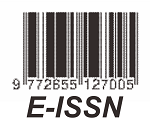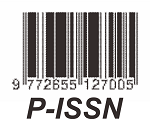PENGARUH RADIASI ELEKTROMAGNETIK TERHADAP KESEHATAN DAN UPAYA PENCEGAHANNYA
DOI:
https://doi.org/10.46918/karst.v7i2.2314Keywords:
blue light; electromagnetic radiation; laptops; microwaves; preventionAbstract
The impact of electromagnetic radiation on health and preventive measures. Laptops emit electromagnetic radiation, including blue light from screens and microwaves from Wi-Fi modules, which pose potential cumulative health risks. This study aims to measure the electromagnetic radiation emitted by laptops, evaluate its impact on user health, and identify applicable preventive measures. The research employed a qualitative method based on library research with a content analysis approach. The findings reveal that blue light intensity ranges from 10–50 µW/cm², while microwave radiation from Wi-Fi reaches up to 2.0 mW/cm² at close distances. Health impacts include eye fatigue, accommodation disorders, and neurological effects such as headaches and fatigue due to prolonged radiation exposure. Identified preventive measures include blue light filters, screen distance adjustments, and low-power Wi-Fi technology. This study offers practical guidelines to minimize health risks associated with electronic device usage.
References
Anies, M. K. (2013). Cepat Tua Akibat Radiasi. Jakarta: Elex Media Komputindo.
Batubara, D. A., Fazirah, C., Syahfitrih, L., Fadilla, M., & Anggraini, R. (2023). Pengaruh Radiasi Elektromagnetik Yang Ditimbulkan Oleh Telepon Seluler. Al-Irsyad Journal of Physics Education, 2(2), 76–85.
Hermawan, M. A., Nurbaiti, U., & Yulianti, I. (2021). Pengaruh Jumlah Komputer terhadap Tingkat Radiasi Elektromagnetik dan Dampak Kesehatan Manusia dalam Lingkungan Teradiasi. Emitor: Jurnal Teknik Elektro, 21(1), 32–34.
Iramanda, D. S. (2021). Quality Assurance (Qa) Dan Quality Control (Qc) Cobalt. Jurnal Biosains Pascasarjana, 23(2), 61–74.
Marta, M. D. A. (2024). Hubungan Unsafe Action Penggunaan Gadget dengan Keluhan Subjektif Kelelahan Mata Pada Mahasiswa Program Studi Psikologi Universitas Jambi Tahun 2023 (Doctoral dissertation, Universitas Jambi).
Monita, D., Hakim, L., & Manik, J. W. (2022). Bimbingan Bahaya Radiasi Gelombang Elektromagnetik dan Blue Light Dari Gadget di SMA 10 Palangka Raya. E-Amal: Jurnal Pengabdian Kepada Masyarakat, 2(1), 609–612.
Mukhlis, M., Yacob, F., & Herpadiar, F. (2024). Pengaruh Efek Radiasi Ponsel Terhadap Kesehatan Manusia. Kompetensi, 1(1), 39–46.
Parenreng, J. M., Wahid, A., Sanatang, S. P., & Yusmalasari, A. (2022). Pengantar Jaringan Komunikasi Nirkabel. Zahira Media Publisher.
Pratama, A., Jumingin, J., & Atina, A. (2021). Pengukuran Radiasi Elektromagnetik Telepon Seluler Berdasarkan Tipe Telepon. Jurnal Penelitian Fisika dan Terapannya (JUPITER), 3(1), 19–23.
Rubin, G. J., Das Munshi, J., & Wessely, S. (2005). Electromagnetic hypersensitivity: A systematic review of provocation studies. Psychosomatic Medicine, 67(2), 224–232.
Seniari, N. M., & Darma, B. W. (2020). Penyuluhan Bahaya Radiasi Gelombang Elektromagnetik Pada Organ Tubuh Mahluk Hidup di Kelurahan Pagutan Barat Mataram. Prosiding Pepadu, 2, 230–235.
Thandung, D. (2014). Tingkat radiasi elektromagnetik beberapa laptop dan pengaruhnya terhadap keluhan kesehatan. eBiomedik, 1(2).
Wismaya, H. S. (2022). Radiasi Medan Elektromagnetik pada Jangkauan Frekuensi Sangat Rendah (Extremely Low Frequency) di Lingkungan Kampus Universitas PGRI Yogyakarta. Jurnal Ikatan Alumni Fisika Universitas Negeri Medan, 8(3), Juli–September 2022.
Yushardi, Y., Sudarti, S., & Hamdi, M. N. (2022). Potensi pengaruh radiasi gelombang elektromagnetik telepon seluler terhadap kesehatan. Jurnal Ilmiah Kesehatan Sandi Husada, 11(2), 316–322.
Downloads
Published
Issue
Section
License
Karst : Jurnal Pendidikan Fisika dan Terapannya, adalah Jurnal Akses Terbuka (Open Access Journal). Penulis yang menerbitkan artikelnya dalam jurnal ini setuju dengan ketentuan berikut:

This work is licensed under a Creative Commons Attribution-ShareAlike 4.0 International License.
You are free to:
- Share — copy and redistribute the material in any medium or format
- Adapt — remix, transform, and build upon the material for any purpose, even commercially.
- Attribution — You must give appropriate credit, provide a link to the license, and indicate if changes were made. You may do so in any reasonable manner, but not in any way that suggests the licensor endorses you or your use.
- ShareAlike — If you remix, transform, or build upon the material, you must distribute your contributions under the same license as the original.
- No additional restrictions — You may not apply legal terms or technological measures that legally restrict others from doing anything the license permits.








94.jpg)

















